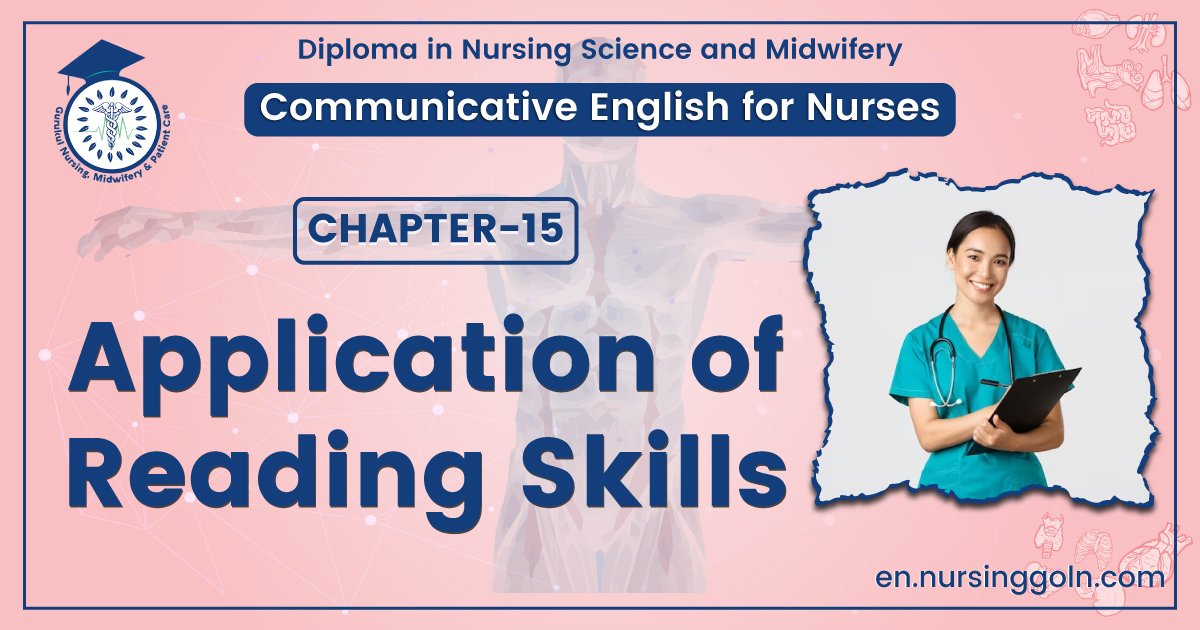Application of Reading Skills – The course is designed to develop communication skills in English and computer and information technology (ICT) of the learners. Communicative English includes the basic grammatical structures of English and basic semantics, basic reading and listening techniques for constructing informal writings; reading selected English literature; listening to selected English media; use of expressions for easy communication in daily life such as exchanging information, greeting, shopping, application, past, present & future activities, liking & disliking etc; giving English oral presentations; and writing formal letters and essays.
Study and practice in reading and writing on related topics from nursing textbooks/journals/magazines & note taking, referencing; improvement of reading and writing abilities with emphasis on review of vocabularies, sentence structure, organization, development of oral presentation; developing writing skills Business letters, application & CV; report writing, editing, proof reading, translation and professional writings-meeting minutes; improvement of speaking and listening abilities with establishing communication and making arguments.
Computer and information technology is designed for understanding of using computer and information technology; it applications in nursing field; application programs for Microsoft Word processing, Microsoft Excel for spreadsheets, Power Point Presentations, Networking and Communication through internet and World Wide Web applications.

Application of Reading Skills
SKIMMING
Definition of Skimming:
Skumming refers to the process of reading only main ideas within a passage to get an overall impression of the content of a reading selection.
Strategies to Skimming/ How to Skim:
- Read the title.
- Read the introduction or the first paragraph.
- Read the first sentence of every other paragraph.
- Read any headings and sub-headings.
- Notice any pictures, charts, or graphs.
- Notice any italicized or boldface words or phrases.
- Read the summary or last paragraph.
SCANNING
Definition of Scanning
Scanning is a reading technique to be used when you want to find specific information quickly. In scanning you have a question in your mind and you read a passage only to find the answer, ignoring unrelated information.
Strategies to Scan/How to Scan:
- State the specific information you are looking for.
- Try to anticipate how the answer will appear and what clues you might use to help you locate the answer. For example, if you were looking for a certain datę, you would quickly read the paragraph looking only for numbers.
- Use headings and any other aids that will help you identify which sections might contain the information you are looking for.
- Selectively read and skip through sections of the passage.
Scanning is a technique that requires concentration and can be surprisingly tiring. You may have to practice at not allowing your attention to wander. Choose a time and place that you know works for you and dive in.

INTENSIVE READING (IR)
Intensive Reading (IR) occurs when the learner is focused on the language rather than the text. For example, the learner may be answering comprehension questions, learning new vocabulary, studying the grammar and expressions in the text, translating the passage (sometimes called ‘careful reading’), or other tasks that involve the student in looking intensively (inside) the text. Most often all the students read the same short text that the teacher decided.
Ideal learning materials for intensive reading include:
- News articles
- Wikipedia articles
- Short stories
- Blog posts
Benefits of Intensive Reading
- It helps to look at main ideas than details.
- Lets you understand what is implied versus what is stated.
- Helps you in making inferences.
- Lets you look at the order of information and how it affects the message.
- Helps in identifying words that connect one idea to another.
- Lets you Identify words that indicate change from one section to another.
- Intensive Reading provides a base to study structure, vocabulary and idioms.
- It helps students develop a greater control of language.
- It provides a check on the degree of comprehension for individual students.

EXTENSIVE READING
Extensive reading involves learners reading texts for enjoyment and to develop general reading skills. It can be compared with intensive reading, which means reading in detail with specific learning aims and tasks.
Example
A teacher reads a short story with learners, but does not set them any tasks except to read and listen.
Ideal learning materials for extensive reading include:
- Graded Readers
- Bilingual Books
- Monolingual (Native) Books
- Magazines
- Comic Books
| Intensive Reading | Extensive Reading |
| In Intensive reading, the readers read the text line by line understanding the meaning of the text clearly and carefully. | Extensive reading involves reading rapidly. In this kind of reading attention is paid to the meaning of the text itself, not the language. |
| Intensive reading is done to get the literal meaning of the text | Extensive reading is done for pleasure and information. |
| Readers are also concerned with the meaning of individual words or sentences. | Readers are more concerned about understanding the meaning of the text than the meaning of individual words or sentences. |
| Oral reading is the example of intensive reading | Silent reading is the example of extensive reading |
| Intensive reading means reading some matter very thoroughly and deeply | Extensive reading means to read a lot of matter. |
| Intensive reading means reading a single book to get its literal meaning | Extensive reading means reading diverse books of similar ideas. |
PREDICTING
Predicting is an important reading strategy. It allows students to use information from the text, such as titles, headings, pictures and diagrams to anticipate what will happen in the story.
Importance:
- Making predictions activates students’ prior knowledge about the text and helps them make connections between new information and what they already know.
- By making predictions about the text before, during, and after reading, students use what they already know as well as what they suppose might happen to make connections to the text.

INFERRING
The skill of inferring is closely related in the fields of science and literacy. As a reading strategy. inferring requires readers to use prior knowledge and the information stated in a text to draw conclusions.
How to teach inference
One simplified model for teaching inference includes the following assumptions:
- We need to find clues to get some answers.
- We need to add those clues to what we already know or have read.
- There can be more than one correct answer.
- We need to be able to support inferences.
SIMILE
Definition of Simile:
A simile is an explicit comparison between two different things “as” and “like” are used in it.
Example:
We die,
As your hours do, and dry
Away
Like to summer’s rain
(Robert Herrick: To Daffodils)
In this lines human life has been compared to summer’s rain drops to suggest that a man’s life is as a drop of summer’s rain that evaporates in no time. Writers use similes Very frequently because similes help them suggest their meanings.
Some examples of well-known similes:
“My affection hath an unknown bottom, like the Bay of Portugal”
(Shakespeare: As You Like It, Act IV, Scence I)
ALLUSION
Allusion is a brief and indirect reference to a person, place, thing or idea of historical, cultural, literary or political significance. It does not describe in detail the person or thing to which it refers
Example:
Look at some common allusion examples in everyday life:
- “Don’t act like a Romeo in front of her.” “Romeo” is a reference to Shakespeare’s Romeo, a passionate lover of Juliet, in “Romeo and Juliet”.
- The rise in poverty will unlock the Pandora’s box of crimes. This is an allusion to one of Greek Mythology’s origin myth, “Pandora’s box”
- “This place is like a Garden of Eden.” This is a biblical allusion to the “garden of God” in the Book of Genesis.
- “Hey! Guess who the new Newton of our school is?” “Newton”, means a genius student, alludes to a famous scientist Isaac Newton.
- “Stop acting like my ex-husband please.” Apart from scholarly allusions we refer to common people and places in our speech.

METAPHOR
A metaphor is a kind of figurative language that compares two different things or ideas. Unlike a simile, a metaphor makes this comparison without using the words “like” or “as.” Sometimes, the two things or ideas in a metaphor will be very much like one another, other times, they will be different.
Example:
- The detective listened to her tales with a wooden face.
- She was fairly certain that life was a fashion show
When to Use Metaphor in Your Writing
Metaphors can make your writing more-engaging and exciting for the reader. You want to strike the right balance between finding an interesting connection and still making your meaning clear For example, if you wrote, “She was a chair,” without any additional information, it’s not clear why you’re comparing a person to a chair.
Be specific and clear, and your use of metaphor will add a lot of richness. For example: “She was a welcoming, familiar armchair.” This sentence gives a much clearer connection, and we understand a little more about who is being described.

IRONY
Irony is a figure of speech in which words are used in such a way that their intended meaning is different from the actual meaning of the words. It may also be a situation that ends up in quite a different way than what is generally anticipated. In simple words, it is a difference between appearance and reality.
Types of Irony
On the grounds of the above definition, we distinguish two basic types of irony:
- Verbal irony, and
- Situational irony.
Verbal irony involves what one does not mean. For example, when in response to a foolish idea, we say, “What a great idea!” This is verbal irony.
Situational irony occurs when, for instance, a man is chuckling at the misfortune of another, even when the same misfortune is, unbeknownst to him, befalling him.
Read More:
